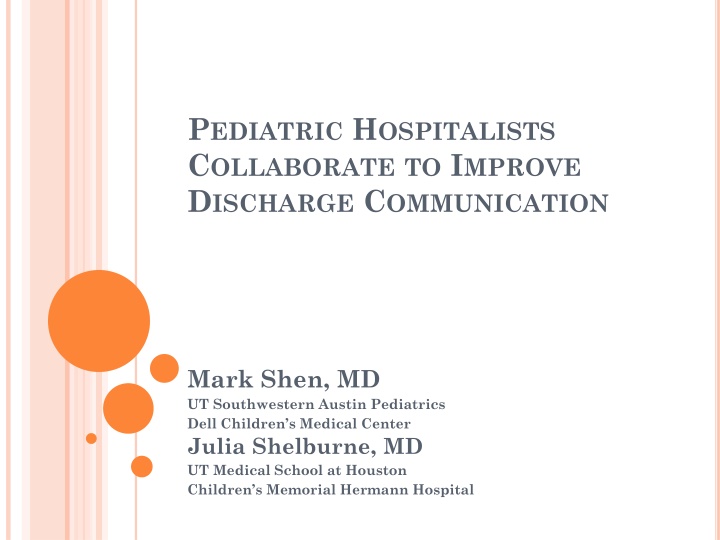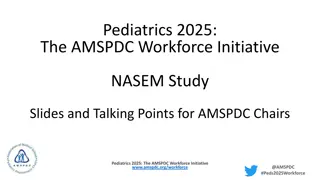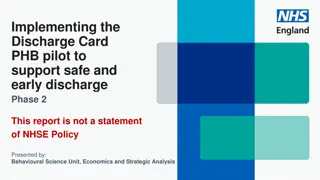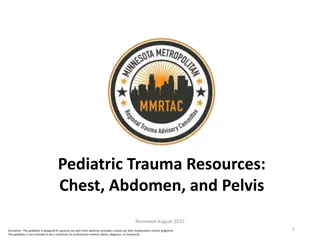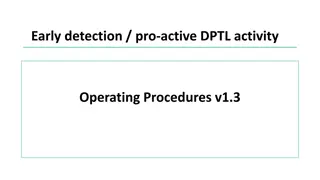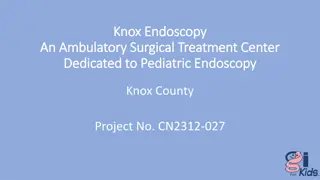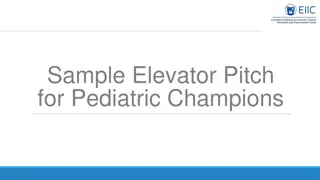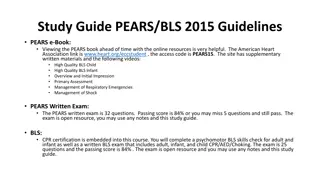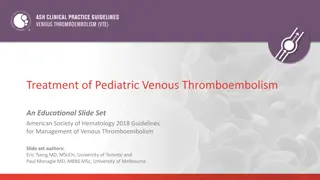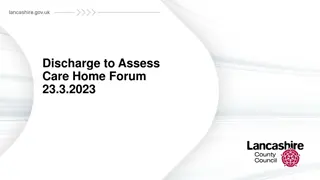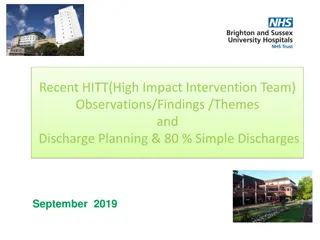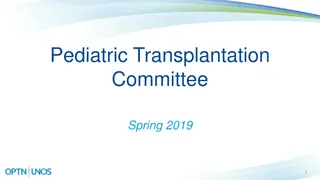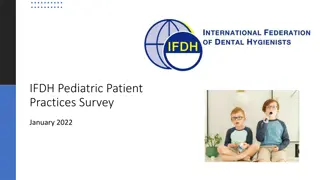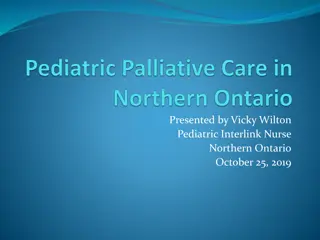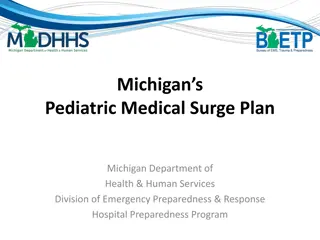Improving Discharge Communication: Collaborative Efforts by Pediatric Hospitalists
Pediatric hospitalists are working together to enhance discharge communication and reduce adverse events post-hospitalization. Learn about the collaboration, core participants, and the importance of effective hospitalist-PCP communication in this initiative.
Download Presentation

Please find below an Image/Link to download the presentation.
The content on the website is provided AS IS for your information and personal use only. It may not be sold, licensed, or shared on other websites without obtaining consent from the author.If you encounter any issues during the download, it is possible that the publisher has removed the file from their server.
You are allowed to download the files provided on this website for personal or commercial use, subject to the condition that they are used lawfully. All files are the property of their respective owners.
The content on the website is provided AS IS for your information and personal use only. It may not be sold, licensed, or shared on other websites without obtaining consent from the author.
E N D
Presentation Transcript
PEDIATRIC HOSPITALISTS COLLABORATE TO IMPROVE DISCHARGE COMMUNICATION Mark Shen, MD UT Southwestern Austin Pediatrics Dell Children s Medical Center Julia Shelburne, MD UT Medical School at Houston Children s Memorial Hermann Hospital
BACKGROUND: PHM Pediatric Hospital Medicine tri-sponsorship American Academy of Pediatrics (AAP) Academic Pediatric Association (APA) Society of Hospital Medicine (SHM) 2009 PHM Roundtable Strategic Planning Commissioned 3 Quality Improvement Collaboratives with mentorship from national leaders in pediatric QI
BACKGROUND Co-Chairs of Transitions of Care Collaborative Mark Shen, MD, enrolled in the CS&E course Julia Shelburne, MD, a graduate of the UT Houston Physician Quality and Safety Academy Elected to focus on Hospitalist-PCP communication Representatives from 15 other pediatric hospitalist groups enrolled Project was time-limited to 9 months
CORE PARTICIPANTS Lora Bergert: Kapi`olani Medical Center, Honolulu Michael Bryant: USC Keck School of Medicine David Cooperberg: St. Christopher s, Philadelphia Dan Coughlin: Hasbro Children s, Providence Leah Mallory: Barbara Bush Children s Hospital at Maine Medical Center, Portland Beth Robbins: Anne Arundel Medical Center, Annapolis Julia Shelburne: UT-Houston Medical School/Children s Memorial Hermann Hospital Mark Shen and Don Williams: UT-Southwestern, Austin/Dell Children s Medical Center, Austin Ann Vanden Belt: St. Joseph Mercy Hospital, Ypsilanti, MI Joyce Yang, Dan Hershey, and Erin Stucky: Rady Children s Hospital, San Diego
HOSPITALIST-PCP COMMUNICATION: A HIGH-RISK HANDOFF In studies of adult patients, approximately 20% of hospitalized patients experience an adverse event after discharge Many (1/2 to 2/3) are preventable or ameliorable Most common type: adverse drug events Forster AJ, et al. The incidence and severity of adverse events affecting patients after discharge from the hospital. Ann Intern Med. 2003;138(3)161-7. Forster AJ et al. Adverse events among medical patients after discharge from hospital. CMAJ 2004; 170(3):345-9.
HOSPITALIST-PCP COMMUNICATION: A HIGH-RISK HANDOFF Poor communication between hospitalists and outpatient providers: Only 17% to 20% of PCPs always notified of discharge Only 3% of PCPs reported being involved in communication regarding discharge 11% of discharge letters and 25% of discharge summaries never reached the PCP Kripalani, S et al. Deficits in communication and information transfer between hospital-based and primary care physicians: implications for patient safety and continuity of care. JAMA. 2007;297:831- 841.
HOSPITALIST-PCP COMMUNICATION: A HIGH-RISK HANDOFF Communication rarely timely PCPs and patients often made contact before discharge information arrived (16%-88%) Delayed or absent discharge communication was estimated to adversely affect management in 24% of cases In one study, only 24.5% of discharge summaries were available for at least 1 follow-up visit. Trend towards decreased risk of readmission for patients seen for follow-up by a physician that had received a discharge summary Kripalani, S et al. Deficits in communication and information transfer between hospital-based and primary care physicians: implications for patient safety and continuity of care. JAMA. 2007;297:831-841. Van Walraven C, Seth R, Austin PC, Laupacis A. Effect of discharge summary availability during post-discahrge visits on hospital readmission. J Gen Intern Med 2002;17:186-192.
COLLABORATIVE NEEDS ASSESSMENT Survey of referral community: Highly variable preferences on method: 50% email 50% telephone 50% fax Timeliness of discharge communication was desired: 56.3% Same day 23.9% Prior to recommended follow-up appointment 14.1% Within 72 hours
COLLABORATIVE DIVERSITY Broad scope of potential projects Wide range of experience with QI Varying degrees of institutional support Spectrum of EMR implementation and technical/systems sophistication Focus on timeliness and reliability
COLLABORATIVE AIM STATEMENTS Global Aim: We will create a discharge infrastructure within our hospitals to achieve measurable improvements in the handoff of patient care at discharge from the hospitalist to the primary care provider. Specific Aim: Over the next 6 months, we will lead a quality improvement collaborative and achieve measureable improvement in the frequency AND timeliness of communication of patient information to the PCPs at discharge. Goal: 90% of hospitalist discharges at each participating hospital will have documentation of communication with a PCP within 2 calendar days of actual discharge.
COLLABORATIVE: PROCESS Monthly conference calls Scheduled topics Standardized data collection and reporting QI didactics Use of QI tools Individual site presentations Open discussion of lessons learned Positive reinforcement! Quarterly collaborative leadership calls Co-chairs of 3 collaboratives & national mentors
STEP 1 - MEASUREMENT Weekly sampling Minimum 12 charts 2 weekdays + 1 weekend day Documentation of communication (email, phone, fax) Simple process for ease of data reporting and viewing Plotted on a collaborative run chart
(SAMPLE SLIDEFROM CONFERENCE CALL) I M MEASURING, BUTSTILLCONFUSED Process Maps, Key Drivers, Pareto Charts, Fishbone Diagrams are all: Diagnostic Tools to help you PLAN your CHANGE (intervention) Step 2: Do you understand your process?
COLLABORATIVE PROCESS Common feedback from the group: I don t understand Key Drivers or Process Maps but I can clearly see 15barriers in my way . Collaborators had a wide range of QI skills A major part of conference calls was devoted to Quality Improvement basics
Patient is Ready for Discharge or has been discharged (same day). Algorithm followed whether PCP known or if only clinic name (distinct) known RCHSD Discharge Communication Process Map YES Do patient needs warrant a personal call ? YES Place call to PCP by end of day NO Document call in patient chart on ward or 2) field in billing program : 1) Does PCP have communication preference ? YES Does PCP have secure email? Communication by fax ? Communication by phone ? Communication by email Complete discharge fax on ward or in office by end of day Place call to PCP by end of day Email PCP by end of day OR 1) Fax on ward 2) Document date/time. 3) Place fax in chart 4) Document in progress note 5) Document in billing field Document call in 1) Patient chart on ward 2) Field in billing program : Document email by 1. Patient chart progress note 2. Field in billing : 1. Give fax to admin 2. Admin faxes notice 3. Record date/time of fax 4. Submit to Chartmaxx for scanning into chart. 5. Notify attending/record faxes not sent in log.
KEY DRIVERS DIAGRAM AIM KEY DRIVERS INTERVENTIONS Faculty, resident, and NP awareness of expectation Education ongoing of faculty and residents (monthly ) IT support to help pull QI data 90% of general pediatric discharges will have instructions, summary or short stay form faxed to PCP within 48 hours IT initiative to enhance PCP information tab in EMR Availability of name of PCP and contact info in EMR Educate residents to ask/document PCP information in eH&P IT support of initiative Ongoing Ad Hoc multidisciplinary meetings Working with IT to find automated solutions (modify discharge template, automated fax from EMR, etc) Personnel assigned to efax info residents, NPs Working with team to efax until auto- fax process in place
RESULTS 100 90 80 70 60 50 A B C D E F G 40 30 20 10 0 1 2 3 4 5 6 7 8 Percent of discharges with documented communication with PCP within 2 calendar days of discharge, by month since go-live"
SUSTAINABILITY: GROUPSENTERING PHASE 2 VIP Discharge Handoff Collaborative: Communication Timeliness 100% 90% % Communication within 2 Days of Discharge 80% A B 70% C 60% D E 50% F G 40% H 30% I J 20% COLLABORATIVE 10% 0% Jan-11 Feb-11 Mar-11 Apr-11 May-11 Jun-11
VALUEOF PEDIATRIC HOSPITALISTS: REFERRING PHYSICIAN SATISFACTION Annual Survey of Austin Pediatric Alliance: Hospitalists received the highest marks for communication Communication is so much better Discharge summaries have been received promptly on a consistent basis I have seen a tremendous improvement with regards to receipt of d/c summaries and faxes regarding admits In general, i think the pcrs service has improved tremendously in the areas of prompt communication Wonderful job getting notification of admissions and d/c summaries to me quickly these days
CHANGE PACKAGE Team buy-in/Leadership engagement Measure Standardize and/or automate processes Provide targeted and timely individualized feedback Keep measuring Incentives
LEARNING COLLABORATIVE FACTORS CONTRIBUTEDTO SUCCESS Learned from peers Received instant feedback Supported, motivated and pushed by the group Learned Quality Improvement I learned to fish Felt accountable to group deadlines
COLLABORATIVE CO-CHAIRS LESSONS LEARNED Plan ahead: timelines, deadlines, conference calls Administrative support is key to a successful collaborative While individual input is a strength of collaboratives, it is up to leadership to keep groups positive and moving forward
UT CS&E Provided Collaborative Co-Chairs with the skills and confidence to lead this collaborative An effective model for experiential learning Combination of didactic theory and practical hands- on learning through projects Provided networking which allowed co-chairs to further this project at their own institution Facilitated development of strong regional and national pediatric QI presence
NEXT STEPS: Continued leadership and administrative support Value in Inpatient Pediatrics (VIP) Network AAP Quality Improvement and Innovation Network (QuIIN) Phase 2 National multi-community needs assessment of primary care physicians (underway) Improve content of discharge communication Apply for Maintenance of Certification (MOC) credit Partner with outpatient pediatric providers to improve outcomes A new Phase 1 Repeat cycle of improving timeliness and learning QI with a new group of enthusiastic hospitalists
NEEDS ASSESSMENT: PEDIATRIC HOSPITALIST PCP COMMUNICATION Single pediatric medical center Telephone survey: 10 pediatric hospitalists and 12 referring pediatric primary care providers Evaluation of Communication issues previously identified in adult literature Quality of communication Barriers to communication Methods of information sharing Key data element requirements Critical timing Perceived benefits Harlan, G, et.al, Pediatric hospitalists and primary care providers: a communication needs assessment. J Hosp Med 2009 Mar;4(3):187-93.
NEEDS ASSESSMENT: PEDIATRIC HOSPITALIST PCP COMMUNICATION Important Elements: Diagnoses Medications Follow-up needs Pending laboratory test results Critical Times for communication Discharge Admission Major clinical changes Harlan, G, et.al, Pediatric hospitalists and primary care providers: a communication needs assessment. J Hosp Med 2009 Mar;4(3):187-93.
19% of patients experienced an adverse event after discharge 1/3 were preventable, 1/3 were ameliorable Adverse drug events were most common Forster AJ, Murff HJ, et al. The incident and severity of adverse events affecting patients after discharge from the hospital. Ann Intern Med. 2003l 138(3):161-7.
23% of patients experienced an adverse event after discharge were preventable or ameliorable Adverse drug events were most common Forster AJ, Clark HD et al. Adverse events among medical patients after discharge from hospital. CMAJ 2004;170(3):345-9.
Systematic review of literature Characterize types and prevalence of deficits Determine efficacy of interventions Most studies were performed outside of the United States Kripalani, S et al. Deficits in communication and information transfer between hospital-based and primary care physicians: implications for patient safety and continuity of care. JAMA. 2007;297:831-841.
FAILURETO MAKE CONTACT Only 17% to 20% of PCPs were always notified of discharge Only 3% of PCPs reported being involved in communication regarding discharge 11% of discharge letters and 25% of discharge summaries never reached the PCP Kripalani, S et al. Deficits in communication and information transfer between hospital- based and primary care physicians. JAMA. 2007;297:831-841. .
MISSING FROM DISCHARGE SUMMARY 100 Median % 90 80 x 70 60 50 40 30 20 10 0 Main diagnosis Consult recs Pending tests Follow-up plans Discharge meds Counseling provided
POOR TIMELINESSOF DISCHARGE COMMUNICATION PCPs and patients often made contact before discharge information arrived (16%-88%) Delayed or absent discharge communication was estimated to adversely affect management in 24% of cases Kripalani, S et al. Deficits in communication and information transfer between hospital-based and primary care physicians. JAMA. 2007;297:831-841.
HOSPITALS PERSPECTIVESONTHE VALUE OF PEDIATRIC HOSPITALIST PROGRAMS Freed GL, Dunham KM, Switalski KE, et. al. Assessing the value of pediatric hospitalist programs: the perspective of hospital leaders. Academic Pediatrics 2009;9(3):192-6.
AAP POLICY STATEMENT Guiding Principles for Pediatric Hospitalist Programs 5. Pediatric hospitalist programs should provide for timely and complete communication between the hospitalist and the physicians responsible for a patient s outpatient management, including the primary care physician and all involved subspecialists. Perclay JM, Strong GB, American Academy of Pediatrics Section on Hospital Medicine. Guiding Principles for Pediatric Hospitalist Programs. Pediatrics2005;115(4): 1101-1102.
Trend towards decreased risk of readmission for patients seen for follow-up by a physician that had received a discharge summary Only 24.5% of summaries were available for at least 1 follow-up visit Van Walraven C, Seth R, Austin PC, Laupacis A. Effect of discharge summary availability during post-discahrge visits on hospital readmission. J Gen Intern Med 2002;17:186-192.
PHM VIP DISCHARGE HANDOFF COLLABORATIVE PHASE 1
PHM-VIP DISCHARGE HANDOFF COLLABORATIVE PHASE 1 NEEDS ASSESSMENT When would you prefer to be notified about your patient s admission to the hospital? 68.8% During business hours but soon after admission At discharge Periodically throughout admission Immediately upon admission 38.6% 32.9 % 20.0 %
PHM-VIP DISCHARGE HANDOFF COLLABORATIVE PHASE 1 NEEDS ASSESSMENT How would you prefer to be notified regarding discharge of your patient from the hospital? 47.9 % 46.5% 46.5 % Electronically (email) Telephone By mail or fax
PHM-VIP DISCHARGE HANDOFF COLLABORATIVE PHASE 1 NEEDS ASSESSMENT When would you prefer that the discharge communication (whether verbal or written) occur? 56.3% 23.9% Same day Prior to recommended follow-up appointment Within 72 hours 14.1%
PHM-VIP DISCHARGE HANDOFF COLLABORATIVE PHASE 1 NEEDS ASSESSMENT If your patient is discharged when you are not personally available (holiday, weekends, evenings), then how should you be notified? 42.3% 36.6% 28.2% 22.5% Electronically (email) Fax to the office Contact on-call physician Leave message with office or answering service
PHM-VIP DISCHARGE HANDOFF COLLABORATIVE PHASE 1 NEEDS ASSESSMENT If your patient is discharged when you are not personally available (holiday, weekends, evenings), then how should you be notified? 42.3% 36.6% 28.2% 22.5% Electronically (email) Fax to the office Contact on-call physician Leave message with office or answering service
PHM-VIP DISCHARGE HANDOFF COLLABORATIVE PHASE 1 NEEDS ASSESSMENT What would you consider critical information to include in the initial discharge communication? (Assuming that this is a timely version later followed by a complete, detailed discharge summary). 98.6% 97.2% 95.8 % 93.0% 67.6% 64.8% 39.4% 39.4% 29.6% Diagnoses Brief summary of hospital course Follow-up plans Discharge medications Referrals that need to be processed Pending laboratory results Imaging procedures and results Laboratory results Hospital medications
PHM VIP TRANSITIONSOF CARE COLLABORATIVE PHASE 2 NEXTSTEPS: IMPROVECONTENT, OUTCOMES, QUIIN (MOC) Join us to find out more! David.Cooperberg@DrexelMed.edu mshen@seton.org
